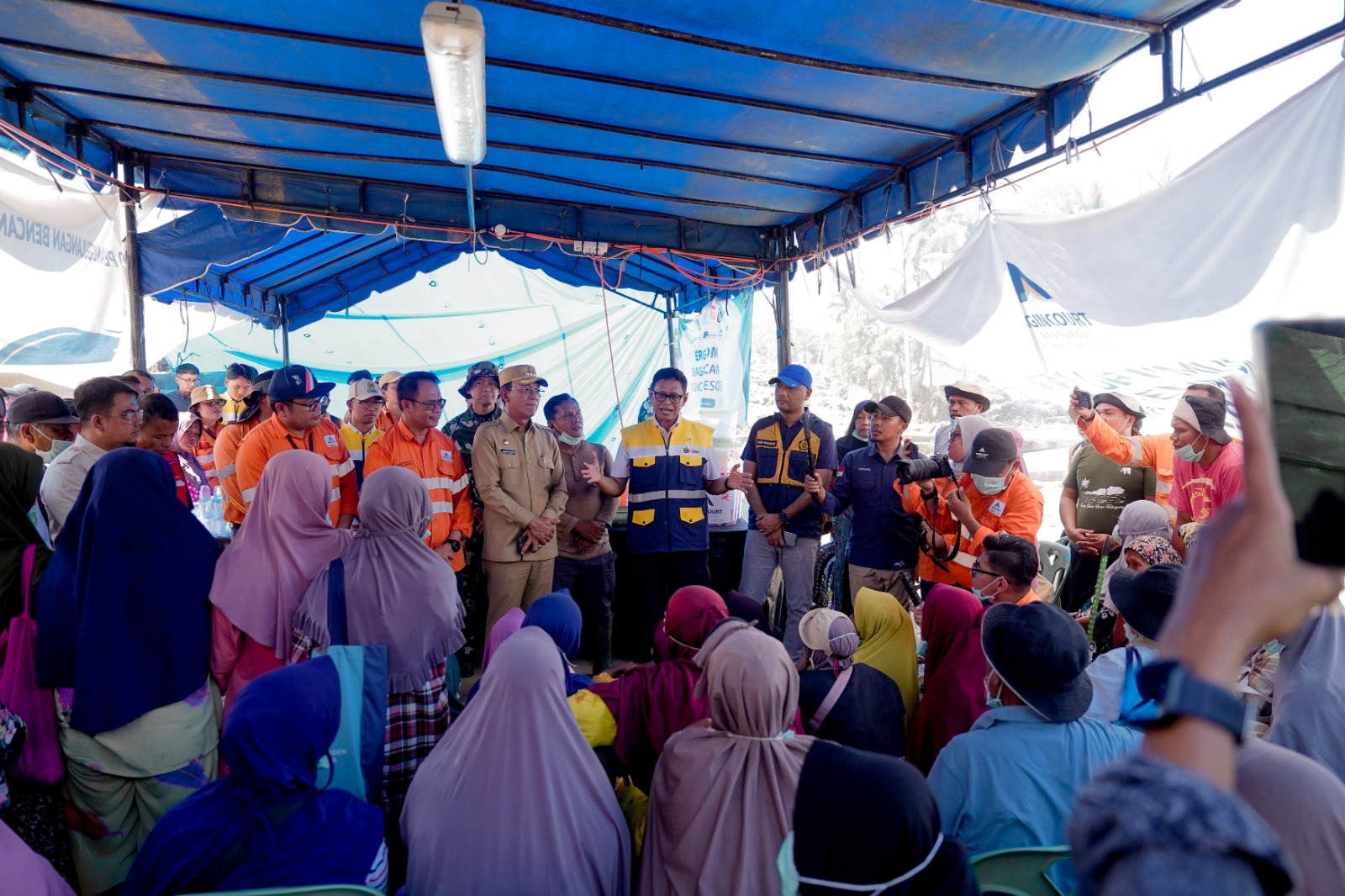With Abundant Sunshine, Indonesia can Meet Electricity Needs from Renewable Energy
MINISTRY OF ENERGY AND MINERAL RESOURCES
REPUBLIC OF INDONESIA
PRESS RELEASE
NUMBER: 303.Pers/04/SJI/2021
Date: 2 September 2021
With Abundant Sunshine, Indonesia can Meet Electricity Needs from Renewable Energy
Indonesia has gigantic potential for renewable energy of over 400,000 megawatts (MW), 50% or about 200,000 MW of which is solar energy potential. The current use of solar energy is only 150 MW or 0.08% of the potential. Located on the equator, Indonesia should become the trailblazer in solar energy development.
"It has become a global culture that the world is moving fast in reducing fossil energy, and switching to environmentally friendly, clean energy. Demands for green products manufactured by green industry is increasing, and even becomes a necessity, if you don't want your products to be subject to a carbon border tax at the global level," said Director General of New, Renewable Energy and Energy Conservation of Ministry of Energy and Mineral Resources (EMR), Dadan Kusdiana, in Jakarta on Thursday (2/9).
On various occasions, the President has also commented in a similar vein, saying that the transformation towards new and renewable energy must start, and that green economy, green technology, and green products must be strengthened to be able to compete on the global market.
Dadan went on to explain that the financing for fossil energy business is getting tighter, while the renewable energy industry is growing rapidly and the price is cheaper over time, especially for solar power. "Based of the 2021 data of IRENA, the capacity of solar power in Vietnam reached 16,504 MW, drastically increasing in three years, in Malaysia 1,493 MW, and in India 38,983 MW," continued Dadan.
To anticipate the trend, the government through the Ministry of EMR has set a target to install 3,600 MW of solar power gradually until 2025. For this reason, the Ministry of EMR will issue a regulation that promotes rooftop solar installation by consumers more widely and collectively, namely by revising Regulation of Minister of EMR Number 49 of 2018 on the Use of Rooftop Solar.
The regulation will offer some stimuli for consumers who wish to install rooftop solar, such as the provision about electricity export to PLN's grid is changed from 65% to 100%, the accumulation period of excess electricity at PLN is extended from three months to six months, and the application period for rooftop solar is shortened to 5-12 days.
"These arrangements apply not only for PLN's consumers but also for those who live in non-PLN business areas; (there will be) an online-based mechanism to facilitate application, reporting, and monitoring of rooftop solar programs, the opportunities for carbon trade from rooftop solar, and a Rooftop Solar Complaint Center to receive complaints from the general public," Dadan added.
In preparing the revision to the ministerial regulation on the use of rooftop solar, the Ministry of EMR has considered and anticipated all those aspects that concern people who wish to install rooftop solar and PLN as the state owned enterprise that is assigned to provide electricity equally.
There are a number of issues that need to be clarified about the deployment of rooftop solar, namely:
One, related to the issue that PLN suffers a loss due to increased exports of electricity from the public. Rooftop solar does not pose any cash-flow problems to PLN, but there is a "potential" for reduced revenues due to lower sales of electricity because people can provide themselves with the electricity from rooftop solar. Rooftop solar will be deployed gradually, so it will not significantly reduce PLN's revenue potential, let alone causing a loss. On the other hand, the government has encouraged PLN to create demands, for example from new industrial estates, smelter industry, induction stoves, and electric vehicles.
The gradual developmet of rooftop solar, which is targeted at about 3,600 MW until the years 2024/2025, has the potential for reducing the fuel cost of Rp7.42 per kWh unit and a saving on gas fuel cost amounting to Rp4.12 trillion per year.
The rooftop solar policy is also in favor of the wider community, because it allows people to make savings on their electricity bills with an installed capacity matching their subscription plan.
Two, related to the issue that the motive for installing rooftop solar has been changed, from a green lifestyle to a profit motive. This is very unlikely because rooftop solar installation is limited to 100% of a consumer's subscription capacity. For example, a consumer who subscribes to a 1,300 VA plan can only install 1,300 VA of rooftop solar maximum; so, there is no such thing as profit hunting. Rooftop solar can only be installed on the roof, walls, or other parts of a building. Installation that uses open space (ground mounted) is not allowed under this scheme.
Another more important fact is that, based on surveys, household rooftop solar exports 24% of its total production to PLN's grid, while industrial rooftop only exports 6% to the grid. The data shows that rooftop electricity is mostly used for self-consumption, not for export.
Three, related to the issues that rooftop solar impacts on PLN's cash flow, adds the electricity subsidy burden, and increases PLN's costs of electricity supply (BPP). The Ministry of EMR has calculated that if rooftop solar with an export rate of 100% is used to replace gas fuel, the BPP will rise by Rp1.14 per kWh (0.08%), subsidy is up by Rp0.079 trillion (0.15%), and compensation will grows by Rp0.24 trillion (1.04%) than if the export rate is set at 65%. Based on the calculation, the government must prepare Rp54.15 trillion for subsidy, but in reality, it will only have to pay Rp53.92 trillion. The difference comes from lower electricity consumption by rooftop solar consumer, with a saving of Rp0.23 trillion.
Four, related to the issue of the impacts on power system stability. To maintain the power system stability, the Ministry of EMR has observed the load curve (duck curve) and operation patterns of PLN. The anticipatory actions taken include:
- Requiring the installation of rooftop solar to obey the Indonesian National Standards (SNI) and/or international standards;
- Requiring industrial rooftop solar consumers to report their system operation plans to the Holder of Electricity Provision Business Licence for Public Interest (IUPTLU) periodically as needed;
- Requiring industrial rooftop solar consumers with a system capacity of over 3 MW to provide database of weather forecast that is integrated with the Supervisory Control and Data Acquisition (SCADA) system or distribution smartgrid of the IUPTLU holder; and
- Assigning PT PLN (Persero) to develop a digital application for rooftop solar usage that is integrated with the SCADA system or distribution smartgrid.
Five, related to the issues that rooftop solar puts a burden on PLN's finances, exacerbates electricity oversupply, and leads to the Take-or-Pay consequences for PLN due to the potential of reduced electricity market. As explained in points one and three, the policy to increase electricity exports to PLN from 65% to 100% has the potential for reducing PLN sales by 0.3 TWh. To illustrate, the plan to add 3,600 MW of rooftop solar gradually under the provision of 65% electricity exports has the potential for reducing PLN's electricity sales by 5.1 TWh. If the provision of electricity export is increased to 100%, PLN's electricity sales will be reduced by 5.4 TWh. Compared with PLN's electricity sales estimate, which this year is around 261 TWh, PLN's sales will potentially decrease by only 0.1%.
PLN can create demand because the electricity market is still huge. The government has shown its support by encouraging the accelerated development of industrial estates and the construction of smelters, both of which need large amounts of electricity. The potential increase in electricity consumption can also come from the use of induction stoves and electric vehicles for the long term.
The development of rooftop solar can become an opportunity for PLN to expand its business against the potential for reduced revenues, for example by selling the carbon credit from rooftop solar consumers other than the industries and businesses.
Six, related to the issue that rooftop solar leads to an increase in electricity subsidies, and therefore, off target. The operational burden of rooftop solar does not impact on PLN's finances but instead increases electricity subsidies in the State Budget. As explained in points three and four about the change in electricity export policy from 65% to 100%, the electricity subsidies in the State Budget increases by around Rp0.08 trillion. On the other hand, the deployment of rooftop solar offers a number of benefits, such as:
- potentially reducing gas fuel consumption by over 47 million MMBTU annually;
- potentially creating employment for 121,500 people;
- potentially creating investment by Rp45-63.7 trillion for the physical construction of solar power and Rp2.04-4.08 trillion for the procurement of expor-import kWh meters;
- promoting green products in the service and green industry sectors;
- potentially reducing greenhouse gas emissions by 4.58 million tonnes of CO2e, which will directly contribute to meeting the NDC target; and
- promoting the growth of the supporting solar power industry in the country because of higher local contents.
Seven, related to the issues of the added value and the economic benefits of rooftop solar that are relatively small because most components are imported, and thus, benefit the producing countries. Indeed, there is no solar power industry that is 100% local. The local contents of solar power system are only around 40%. The sluggish industry is due to the minute market of rooftop solar in Indonesia. In fact, since Ministerial Regulation 49/2018 was issued, the total installed rooftop solar capacity has only reached 35.56 MW (July 2021). This is tiny for Indonesia which has great solar potential. To develop the solar panel industry in the country, efforts must be made to increase the rooftop solar market or consumers significantly. One of these efforts is by revising Ministerial Regulation 49/2018 to attract consumers' interest and grow the market.
If the market thrives, the domestic solar power industry will develop, and the local contents will surge. The price of solar power systems will be cheaper and there is no need to import solar panels. To get there, one needs to undergo a process known as the learning curve of renewable energy.
After going through a short term of renewable energy learning curve, Indonesia will be able to meet its needs for domestic solar power systems, increase the use of clean energy, reduce greenhouse gas emissions and protect the environment as well as fulfill the country's role in creating a better world. (IY)
Head of Bureau of Communication, Public Information Services, and Cooperation
Agung
Pribadi (08112213555)
Share This!






